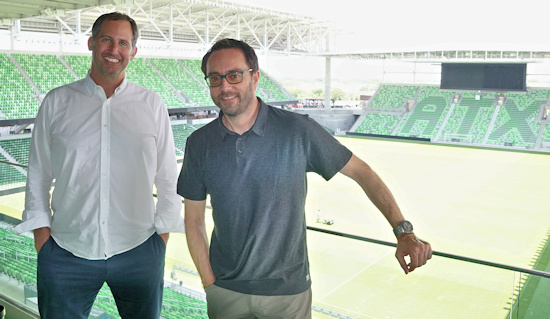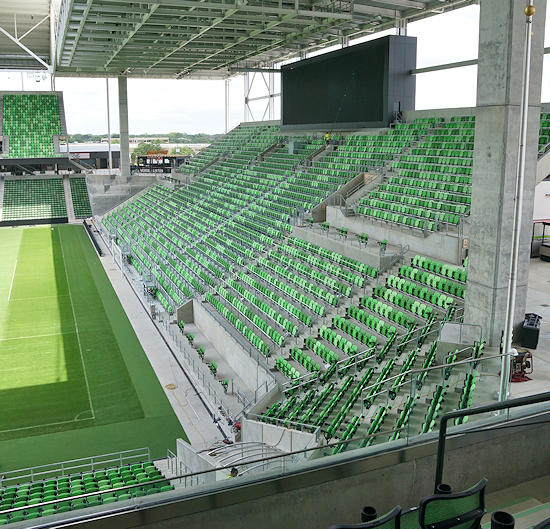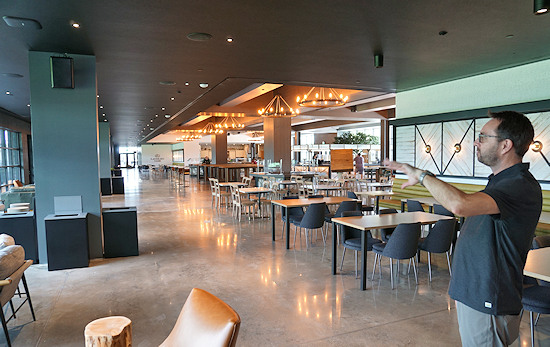
All text and photos by Joe Mock
All rights reserved
AUSTIN, Texas – When the Republican National Convention convened in Houston in 1992, the nomination of George H.W. Bush to represent the party in the November election was a foregone conclusion. You see, he was already the occupant of the White House.
The site of the GOP’s four-day gathering was the Astrodome. Because of the immense preparations to host the event, the Houston Astros were forced to play 26 consecutive road games. This was the longest roadtrip for a Major League team since 1944. Considering the regular season consists of 162 games, that meant the Astros had to be away from home for a stretch that represented 16% of their season.
To that inconvenience, expansion Austin FC of the MLS says simply “that ain’t nothin’.” The black-and-verde clad lads have just completed an eight-game roadtrip to start the 2021 campaign. That represents a staggering 23.5% of the 34-game regular season. The league schedule was established based on the assumption that the team’s brand-new Q2 Stadium wouldn’t be ready for the start of play in mid-April.
 Team President Andy Loughnane notes that while the stadium’s construction had reached “substantial completion” by the start of the season, several external factors prompted the need for a delayed home opener. For instance, traffic lights on the main streets adjacent to the site hadn’t been installed, and key access lanes to a parking lot by the venue needed to be completed.
Team President Andy Loughnane notes that while the stadium’s construction had reached “substantial completion” by the start of the season, several external factors prompted the need for a delayed home opener. For instance, traffic lights on the main streets adjacent to the site hadn’t been installed, and key access lanes to a parking lot by the venue needed to be completed.
“We just can’t host events until all of those infrastructure elements are in place,” he explains.
Despite the rigors of the eight-game span, the team hasn’t fared badly. Those eight road contests yielded two wins, four losses and two ties, for a total of eight points. Averaging at least a point per match away from home is an important component in making the playoffs.
On May 30, the road foe was Seattle. Despite the Sounders boasting the highest scoring offense in MLS, Austin FC held the home team scoreless in a 0-0 tie.
“Without a doubt, we should’ve come away with a couple of goals,” head coach Josh Wolf said after the match. “This is what it’s like every week on a roadtrip.”
The most recent road opponent was Kansas City on June 12. Despite an earlier 2-1 loss there on May 9, Austin FC managed a 1-1 tie. Their total of 8 points places them 10th in the 13-team Western Conference — quite respectable for a squad that has yet to play its first game on its home pitch.
AT ITS LOUDEST
Thanks to a green light given by Austin city leaders, a full capacity will be permitted at 20,500-seat Q2 Stadium at the home opener on June 19 at 8:00 p.m. Central Time. The opponent will be one of the MLS’s original 10 teams, the San Jose Earthquakes.
Considering that there are more fans on the waiting list for season tickets than there are seats in the stadium, you can count on a capacity crowd at the opener. Because of that, “It will be at its best, at its loudest,” says Gensler’s Jonathan Emmett, Design Director on Q2 Stadium. “It will be the full experience of seeing, hearing (and) smelling.”
 |
| Andy Loughnane, President of Austin FC, and Gensler’s Design Director on Q2 Stadium Jonathan Emmett, provided us with an exclusive look behind the scenes of the $250-million venue. |
Because the stadium is across the street from the upscale mixed-use development called The Domain, fans will have plenty to do before the game. “Between the club and the design team,” Emmett explains, “we thought about this experience not being just the 90 minutes of the game. It’s people coming to the whole district, (with) the build-up, the energy before the game.”
In the design process, Emmett says quite a few studies were conducted – on air flow, shade and especially sound. The results determined “the shape of the (seating) bowl and the shape of the roof to contain and reflect the sound. This will be a loud, intimidating environment. I think the first home match will set the tone for the season.”
He adds that “we wanted the biggest canopy possible, but we still need to grow grass, because MLS prefers natural grass.” The natural turf is seashore paspalum, grown in Arizona and shipped to Austin in refrigerated trucks. Even though the sun hits the entire field at mid-day, grow-lights are used to supplement the sunlight around the edges and corners.
Also aiding the growth of the grass is the airflow permitted by keeping the four corners of the stadium open. It makes the temperature more bearable for the spectators, too. “We had to come up with the key balance between the intimacy of the stadium and the airflow,” explains Emmett.
The south stands feature the Supporters Section, built at a steep 34-degree pitch. It features positions for 4,000 standing, screaming patrons. Even though each position features a fold-down seat, those will be locked in an upright position for MLS matches. FIFA-sanctioned events, though, require that the seats be folded down. That means the very first event at Q2 Stadium will have seated fans in this area.
 |
| The steep stands of the Supporters Section as seen from The Porch, the uppermost level of the west stands. For MLS matches, the seat bottoms of the Supporters Section will be locked in an upright position. When the U.S. Women’s National Team plays here, they will be folded down. |
HERE COME THE WOMEN, THEN THE MEN
That’s because the venue’s inaugural event will precede Austin FC’s home opener by three days. On June 16, the U.S. Women’s National Team, the reigning FIFA Women’s World Cup champs, will play an exhibition against Nigeria at Q2 Stadium. Tickets to the friendly sold out quickly.
“It’s an honor for us to have arguably the most popular team in the United States to open the stadium,” notes Loughnane. “This match is the byproduct of conversations that go back early in the concept of there being Austin FC and Q2 Stadium. Ultimately we were able to align a schedule of their pre-Olympic competitions with the building being ready.”
He adds that such an event helps achieve a “core objective” for the facility. “We built the stadium to accommodate year-round activity. Whether it’s the Women’s National Team, the Men’s National Team, World Cup qualifiers one day (or) other international friendlies, those are all part of our roadmap of filling out a full schedule for the building.”
In April, it was announced that one of the two semifinals in the 2021 CONCACAF Gold Cup will be held at Q2 Stadium in late-July.
Such matches are important, because the construction of the $250-million stadium was “100% privately financed by Austin FC’s equity partners,” explains Loughnane. For such a venture to be financially viable, it needs to host concerts and other soccer events beyond the MLS’s 17 regular-season games.
For concerts, the Supporters Section can be pushed back like high-school bleachers, allowing room for a stage. Supports for stage lights are already built into the underside of the canopy on that end of the field.
 |
| Emmett points out the features of the Lexus Club, the largest of the lounges in the stadium. Each lounge has its own decor. |
Under the stands, fans will find lavishly decorated lounges, with the largest being the Lexus Club on the stadium’s west side. “The most exclusive space in the facility is the Q2 Club,” explains Emmett. “Only 380 people can fit here, plus the players for both teams actually walk through this area on their way to the field prior to matches.”
 |
| This is the exclusive Q2 Club. Here members will be able to purchase merchandise that is only sold here. Also, members of both teams march through here on their way to the pitch prior to start of the match. |
ONE OF THREE
Q2 Stadium isn’t the only new venue in Major League Soccer in 2021.
FC Cincinnati had the annoyance of a three-game roadtrip to start the regular season before opening the curtain on $250-million TQL Stadium on May 16. The 26,000-seat showplace features a unique façade with 513 (513 is Cincinnati’s area code, you see) “fins” that light up in dazzling and colorful sequences. Since the rooters’ March to the Match arrives at the pitch from the east, the spacious East Plaza acts as the facility’s front porch.
Populous designed the stadium, which “harnesses the energy of the fans to create a world-class soccer atmosphere,” says Jonathan Mallie, the architecture firm’s Principal in Charge.
The defending MLS Cup champion Columbus Crew is finally getting its long-desired new venue. Dubbed New Crew Stadium, it will debut against New England on July 3. The $314-million facility was designed by HNTB.
Part of its 20,000 capacity is the Nordecke Supporters Section. It provides standing positions for 3,356 boisterous fans at a borderline-scary 37-degree pitch. Right behind these positions is, the team claims, the first beer garden specifically for a supporters’ section in MLS.
The three new venues are designed specifically for soccer and, in fact, have quite a few similarities. All have sleek roofs that cover the seats but not the natural-grass pitch. The three privately financed facilities each cost at least a quarter of a billion dollars to build and seat from 20,000 to 26,000.
Emmett says capacities in this range are “the sweet spot for the energy and the intimacy” for soccer facilities. “We also want this to be a hot ticket. The last thing you’d want is for there to be more tickets than demand.”
Considering the length of Austin FC’s waiting list for season tickets, they needn’t have worried.
Mock operates BaseballParks.com and covers sports facilities for USA TODAY publications